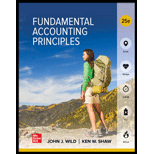
1.
Concept Introduction:
Activity-based costing: Activity-based costing is one of the cost allocation methods where
The activity rates for both types.
2.
Concept Introduction:
Activity-based costing: Activity-based costing is one of the cost allocation methods where overhead costs are allocated based on activity usage. It can be determined by using multiplying activity rate and activity usage. Activities can be classified as production, setups, design, and factory services.
The overhead cost for each type of glass.
3.
Concept Introduction:
Activity-based costing: Activity-based costing is one of the cost allocation methods where overhead costs are allocated based on activity usage. It can be determined by using multiplying activity rate and activity usage. Activities can be classified as production, setups, design, and factory services.
The product cost per unit for each type of glass.
Want to see the full answer?
Check out a sample textbook solution
Chapter C Solutions
FUND.ACCT.PRIN.
- Can you solve this general accounting question with accurate accounting calculations?arrow_forwardPlease explain the correct approach for solving this general accounting question.arrow_forwardPlease provide the solution to this general accounting question with accurate financial calculations.arrow_forward
- Required information Skip to question [The following information applies to the questions displayed below.]Reba Dixon is a fifth-grade school teacher who earned a salary of $38,000 in 2021. She is 45 years old and has been divorced for four years. She receives $1,200 of alimony payments each month from her former husband (divorced in 2016). Reba also rents out a small apartment building. This year Reba received $50,000 of rental payments from tenants and she incurred $19,500 of expenses associated with the rental.Reba and her daughter Heather (20 years old at the end of the year) moved to Georgia in January of this year. Reba provides more than one-half of Heather’s support. They had been living in Colorado for the past 15 years, but ever since her divorce, Reba has been wanting to move back to Georgia to be closer to her family. Luckily, last December, a teaching position opened up and Reba and Heather decided to make the move. Reba paid a moving company $2,010 to move their…arrow_forwardAccounting 12 Could an expert provide a brief summary highlighting one unique feature of the app, recommend it to Sadie—who wants to avoid payroll hassles—and suggest it as she plans to hire employees to extend her dog grooming salon hours?arrow_forwardTally & Co. incurred a pretax operating loss of $100,000 in its first year of operations for both financial reporting and income tax purposes. However, it expects to be profitable in the future. Its expected future income tax rate is 25%.arrow_forward
- Can you help me solve this general accounting problem with the correct methodology?arrow_forwardThere are different tools for analyzing the financial statements of a company, such as horizontal analysis, vertical analysis, ratios for measuring financial health and profitability, and so forth. Why do we need different tools for analyzing financial statements? Don't the numbers in the financial statements speak for themselves?arrow_forwardPlease help me solve this financial accounting question using the right financial principles.arrow_forward
- Principles of Accounting Volume 2AccountingISBN:9781947172609Author:OpenStaxPublisher:OpenStax College
 Cornerstones of Cost Management (Cornerstones Ser...AccountingISBN:9781305970663Author:Don R. Hansen, Maryanne M. MowenPublisher:Cengage Learning
Cornerstones of Cost Management (Cornerstones Ser...AccountingISBN:9781305970663Author:Don R. Hansen, Maryanne M. MowenPublisher:Cengage Learning Managerial AccountingAccountingISBN:9781337912020Author:Carl Warren, Ph.d. Cma William B. TaylerPublisher:South-Western College Pub
Managerial AccountingAccountingISBN:9781337912020Author:Carl Warren, Ph.d. Cma William B. TaylerPublisher:South-Western College Pub  Managerial Accounting: The Cornerstone of Busines...AccountingISBN:9781337115773Author:Maryanne M. Mowen, Don R. Hansen, Dan L. HeitgerPublisher:Cengage Learning
Managerial Accounting: The Cornerstone of Busines...AccountingISBN:9781337115773Author:Maryanne M. Mowen, Don R. Hansen, Dan L. HeitgerPublisher:Cengage Learning Principles of Cost AccountingAccountingISBN:9781305087408Author:Edward J. Vanderbeck, Maria R. MitchellPublisher:Cengage Learning
Principles of Cost AccountingAccountingISBN:9781305087408Author:Edward J. Vanderbeck, Maria R. MitchellPublisher:Cengage Learning Financial And Managerial AccountingAccountingISBN:9781337902663Author:WARREN, Carl S.Publisher:Cengage Learning,
Financial And Managerial AccountingAccountingISBN:9781337902663Author:WARREN, Carl S.Publisher:Cengage Learning,





